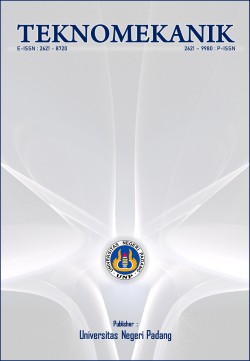Engineering and economic analysis of sawdust biomass processing as a co-firing fuel in coal-fired power plant boiler pulverized coal type
DOI:
https://doi.org/10.24036/jptk.v5i3.27723Keywords:
NRE, Biomass, co-firing, feasibility, optimizeAbstract
One type of alternative fuel that has the potential to be developed and can contribute significantly to the NRE mix is biomass. The significance of the energy mix is obtained from the use of the co-firing system at the Coal-Fired Power Plant (CFPP) by mixing coal fuel with biomass such as sawdust. Sawdust biomass as cofiring material for CFPP is very efficient because it has energy content and availability that is easy to manage. The aim of this research is to make technical and economic analysis of sawdust biomass as solid fuel for pulverized coal CFPP Co-firing type boiler. The research stages are mapping the potential of sawdust biomass to determine the availability of potential biomass around the location of the co-firing, analyze the technical side and specifications contained in sawdust biomass raw materials to determine the suitability or feasibility of pulverized coal type CFPP specifications, and analyze the economic feasibility of developing sawdust biomass processing technology to determine the cost of production of sawdust biomass so that later it will not have a technical and financial impact. The results of the economic analysis show that the sawdust biomass production business is feasible with NPV parameters > IDR 5,252,097,371, IRR=11.1% and payback period=7.7 years. Provided that if the PLTU Rembang buys biomass at a price of Rp. 862,730/Ton. Sensitivity analysis is used to determine the steps to optimize the adjustment of the ability to purchase biomass from CFPP Rembang where the reference limit for the highest reference price for biomass is IDR 782,006. Efforts that can be made to adjust the ability to purchase biomass from the CFPP Rembang include increasing the yield by 20% or reducing the price of wood by 20%.
Downloads
References
Ministry of Energy & Mineral Resources. (2020). Handbook of Energy & Economic Statistics of Indonesia 2020, Indonesia.
PT Perusahaan Listrik Negara. (2020). PLN Laporan Tahunan Annual Report 2020. PLN, Indonesia.
PSE UGM, PLN. (2020). Studi Potensi EBT dan Perencanaan Program Ekosistem Listrik Kerakyatan. UGM. Indonesia.
Pang, S. (2019). Advances in thermochemical conversion of woody biomass to energy, fuels, and chemicals. Biotechnology advances, 37(4), 589-597.
Roni, M. S., Chowdhury, S., Mamun, S., Marufuzzaman, M., Lein, W., & Johnson, S. (2017). Biomass co-firing technology with policies, challenges, and opportunities: A global review. Renewable and Sustainable Energy Reviews, 78, 1089-1101.
IRENA. (2012). Biomass for Power Generation. International Renewable Energy Agency. Vol 1: Power Sector.
IRENA. (2013). Biomass co-firing. Technology Brief. International Renewable Energy Agency.
IRENA. (2022). Renewable Power Generation Costs in 2021. International Renewable Energy Agency. Abu Dhabi.
IEA ETSAP. (2010a). Technology Brief E01. April 2010.
IEA ETSAP. (2010b). Technology Brief E05. May 2010.
U.S. Department of Energy. (2004). Biomass Cofiring in Coal-Fired Boilers. DOE/EE-0288.
O’Connor, D. (2011). Biomass Power Technology Options. Presentation of Electrical Power Research Institute (EPRI) to the U.S Department of Energy Biomass 2011. USA.
Tanbar, Fefria, Purba,Sahrijal. Samsudin, Agus Salim. Supriyanto, Eko. Aditya, Indra A. (2021). “Analisa Karakteristik Pengujian Co-Firing Biomassa Sawdust Pada Pltu Type Pulverized Coal Boiler Sebagai Upaya Bauran Renewable Energy”. Jurnal Offshore, Volume 5 No. 2.
Downloads
Published
Issue
Section
License
Copyright (c) 2022 juwani efendi, Iwa Garniwa

This work is licensed under a Creative Commons Attribution 4.0 International License.





